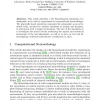Free Online Productivity Tools
i2Speak
i2Symbol
i2OCR
iTex2Img
iWeb2Print
iWeb2Shot
i2Type
iPdf2Split
iPdf2Merge
i2Bopomofo
i2Arabic
i2Style
i2Image
i2PDF
iLatex2Rtf
Sci2ools
VW
2000
Springer
2000
Springer
A 3-D Biomechanical Model of the Salamander
This article describes a 3D biomechanical simulation of a salamander to be used in experiments in computational neuroethology. The physically-based simulation represents the salamander as an articulated body, actuated by muscles simulated as springs and dampers, in interaction with a simple environment. The aim of the simulation is to investigate the neural circuits underlying the aquatic and terrestrial locomotion of the real salamander, as well as to serve as test bed for investigating vertebrate sensorimotor coordination in silico. 1 Computational Neuroethology This article describes the design of a 3D biomechanical model for experiments in computational neuroethology [1, 2], a field which studies how behaviors of an autonomous agent (a simulated animal or a robot) arise from neural circuits. A central aspect of computational neuroethology is that it integrates the simulated central nervous system into a body and an environment, and that it investigates behavior as the result of a s...
Computational Neuroethology | Neural Circuits | Neuroethology This Article | Virtual Reality | VW 2000 |
Related Content
| Added | 26 Aug 2010 |
| Updated | 26 Aug 2010 |
| Type | Conference |
| Year | 2000 |
| Where | VW |
| Authors | Auke Jan Ijspeert |
Comments (0)

